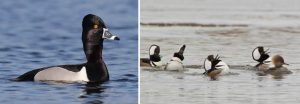Rachel Carson and Gloomy Spring
Bob Musil, President, Rachel Carson Council
Against the pervasive grayness and uncertainty of a climate-change induced early spring and the bleak political scene in Washington, Musil begins to slowly open up to the smallest differences in color and light along the Potomac River and C&O Canal. A few Hooded Mergansers or a pair of Common Mergansers seen against the silver sheen of the Potomac — like the moonlit opening of Rachel Carson’s Under the Sea-Wind — bring new clarity, resolve and hope. Literally walking in the footsteps of Rachel Carson, Musil discovers Carson’s “sense of wonder” as mating Bald Eagles and a soaring Great Blue Heron emerge out of the gray gloom.
It is an early spring. It has been for some time. Spring this year, thanks to global warming, has been tentative, slowly opening in February, buds and small flowers peeking out a window cautiously, as if a sudden freeze could still nip them in the bud. It unfurls like the poet e.e. cumming’s line, “Spring is like a perhaps hand.” Today, it is warm for early March, so once again I get out my trusty Trek and head to Great Falls to ride along the C&O Canal by the Potomac River. I want to watch the very first wildflowers emerge.
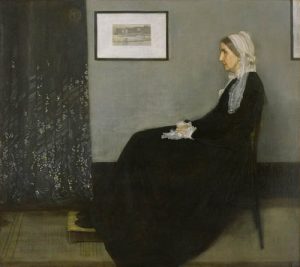 The sky is smeared with gray clouds that take the color out of everything. I am pedaling along in James Whistler’s painting, “Arrangement in Black and Gray, No. 1,” better known as “Whistler’s Mother.” She sits in black, with a bonnet, against a plain, gray wall. The gray and bleakness of the canal, and of Whistler’s mother, reflect the mood in Washington over the election and the winnowing of the Democratic primary to just two gray men to take on the bold orange-yellow of Donald Trump’s face, hair and reckless policies.
The sky is smeared with gray clouds that take the color out of everything. I am pedaling along in James Whistler’s painting, “Arrangement in Black and Gray, No. 1,” better known as “Whistler’s Mother.” She sits in black, with a bonnet, against a plain, gray wall. The gray and bleakness of the canal, and of Whistler’s mother, reflect the mood in Washington over the election and the winnowing of the Democratic primary to just two gray men to take on the bold orange-yellow of Donald Trump’s face, hair and reckless policies.
Grayness signals uncertainty, confusion, perplexity. Do environmentalists and progressives need the red of revolution, or the blue of calm, cool, moderate liberalism? Obama and Biden were thwarted and attacked by Republicans and the right no matter how thoughtful, cool and moderate they seemed or tried to be. Bernie Sanders has achieved little in his time in office while failing, for all his rousing rallies, to increase turnout among the young or overall. The hopes of beating Donald Trump among Democrats, centrist independents, and moderate Republicans are unfolding slowly, like a perhaps hand, cautious and gray like Whistler and the landscape that lies before me.
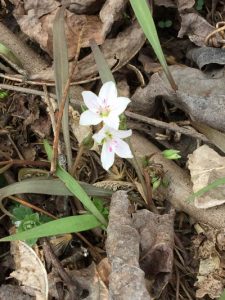
 Soon, I see a few, tiny spots of white among the very gray, brown, buff and sere leaf litter that lines the towpath. I stop to get a look at our earliest wildflowers, small, emerging signs of hope that arise mysteriously from nowhere each and every spring. I stop to peer closely at them and the pink stripes upon their petals. I am alone today. It is eerily quiet. As I kneel before spring beauties, I hear faint rustlings somewhere, much, much lighter than a squirrel. Perhaps a mouse? A little brown bird vaults by me and dives into tangled piles of brush and branches, then pops up, as if in greeting. I am face to face with a Winter Wren, the rare, active, smaller cousin of the cream and chestnut, curved-billed Carolina Wrens that live in my yard and the occasional House Wren in my neighborhood. Its tiny tail is perpendicular, its bill small and straight, its streaks dark and numerous. It looks at me closely, bobs in and out the woody piles, only to stop and peer again in some strange courtship. I smile in return, my inner St. Francis rising to the surface.
Soon, I see a few, tiny spots of white among the very gray, brown, buff and sere leaf litter that lines the towpath. I stop to get a look at our earliest wildflowers, small, emerging signs of hope that arise mysteriously from nowhere each and every spring. I stop to peer closely at them and the pink stripes upon their petals. I am alone today. It is eerily quiet. As I kneel before spring beauties, I hear faint rustlings somewhere, much, much lighter than a squirrel. Perhaps a mouse? A little brown bird vaults by me and dives into tangled piles of brush and branches, then pops up, as if in greeting. I am face to face with a Winter Wren, the rare, active, smaller cousin of the cream and chestnut, curved-billed Carolina Wrens that live in my yard and the occasional House Wren in my neighborhood. Its tiny tail is perpendicular, its bill small and straight, its streaks dark and numerous. It looks at me closely, bobs in and out the woody piles, only to stop and peer again in some strange courtship. I smile in return, my inner St. Francis rising to the surface.
 I bid farewell and wobble slowly forward as spring beauties begin to multiply and fill the floodplain woods. The Potomac and its inlets here are gray and silver, reminding me of the opening of Rachel Carson’s Under the Sea-Wind, her first, carefree book, written before she was preoccupied with chemicals, global warming, factory farms and her own precarious health. “Both water and sand were the color of steel overlaid with the sheen of silver, so that it was hard to say where water ended and land began.”
I bid farewell and wobble slowly forward as spring beauties begin to multiply and fill the floodplain woods. The Potomac and its inlets here are gray and silver, reminding me of the opening of Rachel Carson’s Under the Sea-Wind, her first, carefree book, written before she was preoccupied with chemicals, global warming, factory farms and her own precarious health. “Both water and sand were the color of steel overlaid with the sheen of silver, so that it was hard to say where water ended and land began.”
As I muse, four small ducks, a portrait in black and white, rise to the surface simultaneously and bounce a bit on the surface of the river. I zoom in with binoculars. Amidst the grayness, they shine forth like beacons. These little black and white diving ducks are Ring-necked Ducks, oddly named since the white rings and other markings are on their bills. They dive and rise again and again, happily at home in the cold Potomac, when I spy another clutch of ducks, a small group of Hooded Mergansers, with bold, unmistakably large flags of white flapping on their outsized heads.
 My gazing at the scene before me summons up more black and white upon the gray. A male Common Merganser, much larger than the Hooded, floats slowly, majestically into view. Then, at his side, I see the equally fine-feathered female on the gray waters, her soft, pale chestnut coloring standing out like crimson.
My gazing at the scene before me summons up more black and white upon the gray. A male Common Merganser, much larger than the Hooded, floats slowly, majestically into view. Then, at his side, I see the equally fine-feathered female on the gray waters, her soft, pale chestnut coloring standing out like crimson.
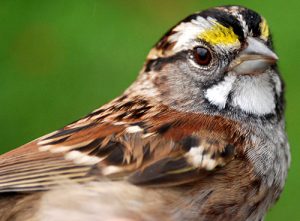 I ride on in grayness, grayness on the path, in the sky, with stands of young beeches, with logs and fungus, with basking turtles gray with drying mud, and the low gray, granite cliffs that Captain John Smith observed when he and his men walked by here over four hundred years ago. The few colors that do show are richer now, the emerald on the heads of Mallard drakes, the chestnut of White-throated Sparrows, the black and white of juncos, the bright red of a single cardinal, the small patches of bright green algae in the water.
I ride on in grayness, grayness on the path, in the sky, with stands of young beeches, with logs and fungus, with basking turtles gray with drying mud, and the low gray, granite cliffs that Captain John Smith observed when he and his men walked by here over four hundred years ago. The few colors that do show are richer now, the emerald on the heads of Mallard drakes, the chestnut of White-throated Sparrows, the black and white of juncos, the bright red of a single cardinal, the small patches of bright green algae in the water.
 I am attuned amidst the gray to the smallest signs of color, of hope, amidst uncertainty. With sparse color, my listening seems sharper, too. Odd, high piping notes I have never heard before are somewhere overhead. I look up to see two Bald Eagles close to each other atop the bare branches of a tree. The sounds repeat as the eagles, one far larger than the other, bring their beaks together. I have never seen eagles court or mate, but there can be no doubt as the smaller eagle mounts the one that seems almost twice its size. The sounds I hear signal the readiness of the much larger female for copulation. New life is being formed before my eyes. There will be eaglets here in just a over a month when real spring, real colors are bursting forth while now there is only gray.
I am attuned amidst the gray to the smallest signs of color, of hope, amidst uncertainty. With sparse color, my listening seems sharper, too. Odd, high piping notes I have never heard before are somewhere overhead. I look up to see two Bald Eagles close to each other atop the bare branches of a tree. The sounds repeat as the eagles, one far larger than the other, bring their beaks together. I have never seen eagles court or mate, but there can be no doubt as the smaller eagle mounts the one that seems almost twice its size. The sounds I hear signal the readiness of the much larger female for copulation. New life is being formed before my eyes. There will be eaglets here in just a over a month when real spring, real colors are bursting forth while now there is only gray.
As if to underscore the symbolism, a little farther on, I spy yet another Bald Eagle that takes off with a large branch grasped within its talons. It salutes as it flies directly over me, crosses the water, and lands in the huge old eagle’s nest I have seen many times along the shore directly across from the C&O’s Mile 18. I watch this pair of eagles as they flap and fuss, refurbishing their home, making it ready for another generation, one that would not exist had not Rachel Carson warned the nation of the peril to our nation’s symbol and our citizens alike.
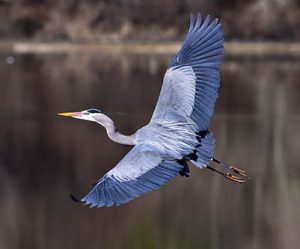 As dusk increases, I turn toward home, renewed and ready. I think of Whistler’s mother against the gray. She seems now resolute, determined. I realize, as the poet Theodore Roethke has said, “In a dark time, the eye begins to see.” My own spirit bird, the Pileated Woodpecker, sets up whoops and a resounding drumbeat as I pass. A line of Ring-billed Gulls, checkmarks of white against the gray, looks down upon me. A huge, primeval Great Blue Heron glides slowly, directly by toward its roost to rest before, soon, a new day will arise. I shall try to do the same.
As dusk increases, I turn toward home, renewed and ready. I think of Whistler’s mother against the gray. She seems now resolute, determined. I realize, as the poet Theodore Roethke has said, “In a dark time, the eye begins to see.” My own spirit bird, the Pileated Woodpecker, sets up whoops and a resounding drumbeat as I pass. A line of Ring-billed Gulls, checkmarks of white against the gray, looks down upon me. A huge, primeval Great Blue Heron glides slowly, directly by toward its roost to rest before, soon, a new day will arise. I shall try to do the same.






